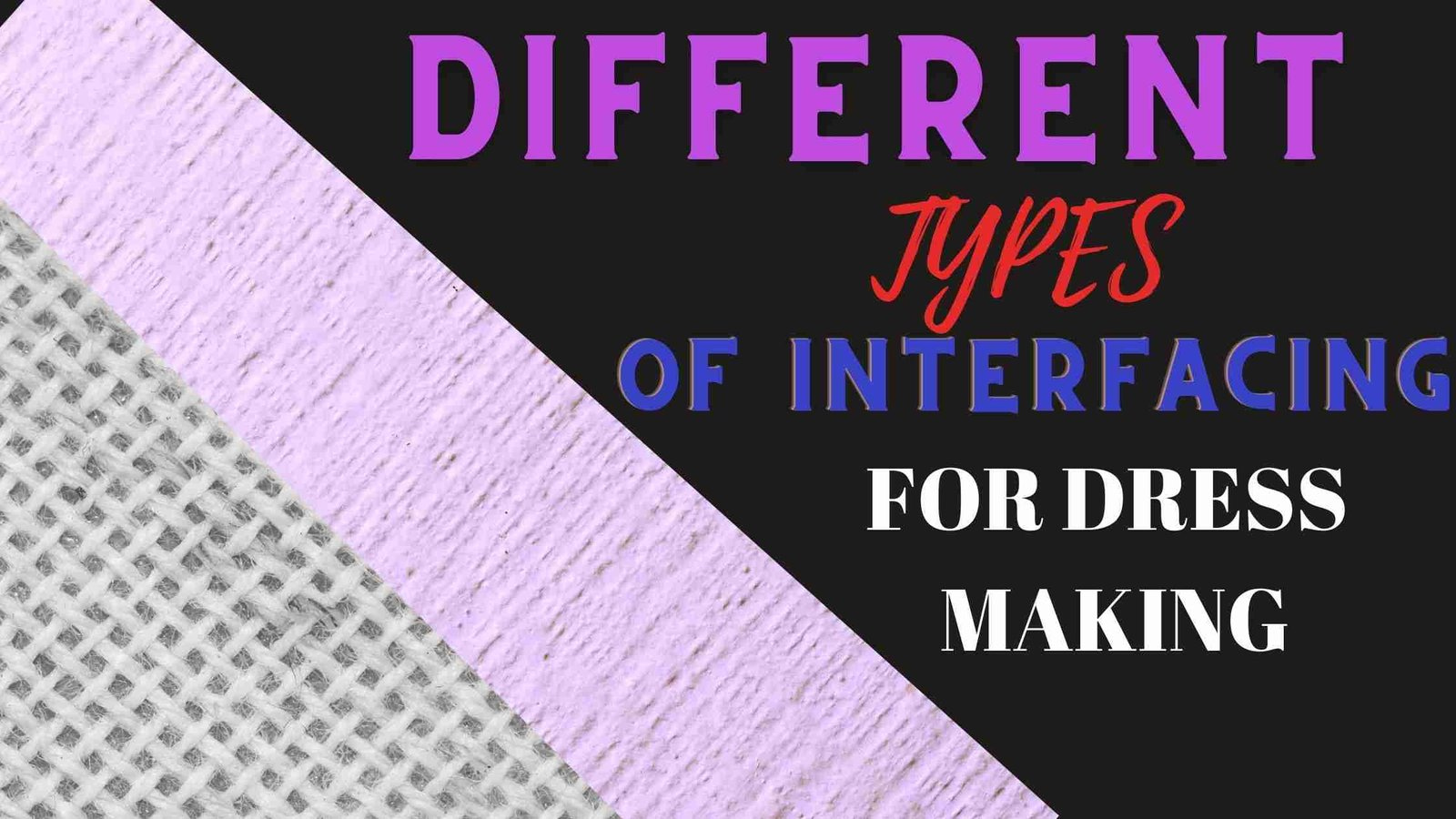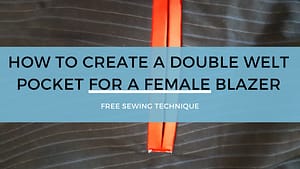As long as you sew,you cannot make any dress without interfacing.As a beginner in sewing,knowing which interfacing to use for which project can be confusing.
This blog post will talk about the different types of interfacing for dress making
I’m going to talk about interfacing,
what it is,
the different types,
and how to use them.
WHAT IS INTERFACING IN SEWING
Interfacing is a material that goes on the inside or between layers of fabric to provide body, stability and stiffness to your fabric. There are different types of fabric for sewing projects.
For example, If you sew with a polyester silky fabric with no interfacing ,it is quite flimsy.
But lightweight fusible interfacing, on the wrong side, gives a lot more body to it .
This makes it easier to create different shapes with it. This would be ideal for waistbands, collars, and cuffs. And These are common dressmaking parts .

The most common colors that you’re going to find is either white or a black /gray. You may be able to find other colors through specialty shops or online.
But if you go to your local fabric store,chances are these are the two colors you’re going to find.
Now you do need to be careful with the color interfacing you use. If you are using a light color fabric such as white or cream you don’t want to use a black interfacing because that’s going to show through and it’s going to look horrible and vice versa.
WHAT IS FUSIBLE INTERFACING MADE OF
Many fibers can be used to make fusible interfacing, but polyester is the most common.
WHAT ARE THE DIFFERENT TYPES OF INTERFACING
This blog post contains affiliate links, which when you click and purchase a product will earn me a commission at no cost to you.Please note that I have worked with this products and that is why I recommend them to you.I have found them to be quite useful in my sewing projects
There are three different types ofinterfacing.
we have ;
You can actually look at this interfacing and see the threads going across and up and down.
This simple means that it has a grain line.
And like fabric you need to follow the grain line direction of this interfacing.
So when you’re cutting out your interfacing pieces you cut them out just like you do on your fabric.
You can’t put your interface pieces any how you like because it is similar to fabric .
However you do need to pre shrink it before you use it.
Allways check the directions when you purchase it so you know how to do that.
Woven interfacing does tend to fray .
But the positive thing is that a lot of people like using this for dress making because it maintains the drape of the fabric you’re working with.

So if draping of the fabric is very important to you then this is a good interfacing to use .
It is very durable.
This interfacing is actually very common.
It is made up of fibers that are just bonded together in no particular order.
The main difference between the woven and non woven interfacing are the grainlines.
The nonwoven interfacing is made up of fibers that are just stuck together.
There is no grain line to it.
So this means you can cut out your pieces any which way and it’s not going to matter. Also it’s not going to unravel .
You don’t also have to worry about pre-shrinking it so it’s very convenient to use .
It’s just not as durable as the woven interfacing
knit interfacing , like the name implies is perfect for knit fabric.
That is because it has some stretch to it .
And also some form of flexibility. The only thing is that it stretches only one wayway It is therefore advisable to be careful when you cut out your pattern pieces .
Ensure it’s going to be the same as your fabric so you can take advantage of that stretch.
DIFFERENT TYPES OF INTERFACING WEIGHTS

Interfacing comes in different weights such as ;
lightweight fusible interface is a lot thinner and gives just a little bit of support to fabric.
Mid weight and heavy weight interfacing are a lot heavier.
These will be ideal for making blazers or handbags.
WHEN TO USE THE DIFFERENT TYPES OF INTERFACING
The different types of interfacing are used with different types of sewing projects.
The choice also depends on either the weight of your fabric or on the project .
So les say I’m doing a simple cotton blouse and I just need a little bit of support.
I’m going to choose the interfacing that’s either close to that or a little bit lighter. That means,with a lightweight fabric ,I’mgoing to use lightweight interfacing.
There are other cases where you’recreating a project where you want something really stiff .
For instance when I’m making my home made bags. Even if I’m using cotton Ankara material, but I want to make it really stiff I can go with the heavy weight interfacing.
HOW TO USE THE DIFERENT TYPES OF INTERFACING
Interfacing can be used in two ways .
Either it’s sewn interfacing or it’s fusible interfacing .
The difference can clearly be seen between the two. The sew in interfacing has this little glue bubbles .So this is sewn in like the name suggests,
The fusible interfacing is actually applied with your iron . You just iron it on,
You may be thinking well this sounds a lot more convenient.
why don’t I just do this one all the time.?
Unfortunately ,not all fabrics can take ironing and the high heat .As a result, there will be some times where you do have to use the sew in interfacing .
A typical example is if you’re working with lace metallic fabrics and velvet .
You really want to use the sew in interfacing as opposed to the fusible
Next we’re going to be talking about ;
HOW TO USE SEW -IN -INTERFACING
Always apply your Interfacing to the wrong side of the fabric.
Take your sew-in- interfacing and apply directly to the wrong side . It needs to be the exact size and shape of your pattern.
So whatever pattern I use to cut out my fabric ,I’m going to use the same pattern for cutting out my interfacing as well.
Then lay it on top of each other .
There’is no right or wrong side to the sew-in- interfacing.
So it doesn’t matter which side I place on the fabric.
Then pin around the perimeter of the whole piece and do a basting stitch around the whole thing .So then we can treat it as one fabric piece.
You can either do the basting stitch at the seam allowance of your piece. So if my seam allowance is 5/8 of an inch, I can do 5/8 of an inch .
HOW TO USE SEW-IN INTERFACING CONTINUED
You can watch the details below
You can make it little bit less than that so maybe instead of a 5/8 seam allowance ,you do a half inch. That way you don’t have to worry about the basting stitches showing after the whole thing is completed,
The basting stitch should be the longest stitch on your sewing machine. You don’thave to worry about doing any backstitching. This is just a temporary stitch just to hold these pieces together .
Because once you start sewing this piece to other pieces in your project, then it’s going to be more permanently sewn in You can use the same technique if you’re also attaching organza as interfacing to your chiffon fabric.
HOW TO USE IRON ON OR FUSIBLE TYPES OF INTERFACING
This is still going to be applied to the wrong side of your fabric .
But you do need to be careful on which side you place your interfacing on.
This is because one side will have the glue bubbles and one side will be smooth .
The side with the glue bubbles goes to the wrong side of the fabric. My fusible interfacing is usually a little bit smaller than my actual fabric piece .
This is totally acceptable because we really don’t need interfacing in our seam allowance.
another important thing is to pre-treat your fabric before applying the interfacing this is always a good idea.
This is in case there’s going to be any shrinking .
HOW TO USE IRON ON INTERFACING
Place your iron on a pretty hot setting.Then take a press cloth and carefully place it over the fabric and interface. then just dampen the fabric a bit .
The dampness and the steam created will help put the interfacing into place. Carefully take your iron ,set it down and leave it down for about six seconds and then move to the next section by carefully lifting it up and setting it down.
Dont shift it across.
Because that could cause wrinkles or shift something underneath
Fuseable interfacing tends to leave fabric a little bit stiffer than the sew-in- interfacing so you do want to may be experiment on little scraps first.
This is to make sure it’s going to have the stability that you want it to.
once you have every thing fused, it is really difficult to takeoff .
WHEN SHOULD YOU USE INTERFACING?
Usually, the pattern packet will tell you what type of interfacing to buy and how much to spend.
.Interfacing is used to stiffen fabric. Patterns for garments will typically call for interfacing in areas that require extra body, such as a shirt collar, or strength, such as buttonholes.
You can use interfacing to keep knit fabric from stretching out of shape when sewing it.
Bags and purses, for example, will typically require interfacing in the bottom of the bag to stiffen it on the bottom and sides so that it can maintain the shape of the bag.
CONCLUSION
Thats my take on the different types of interfacing to use for dress making.I hope you have learnt oneor two things from the blog post.Do you know of any other interface for sewing that I have not mensioned?
Dont hesitat to comment below.
Follow me on pinterest for more sewing tips.





